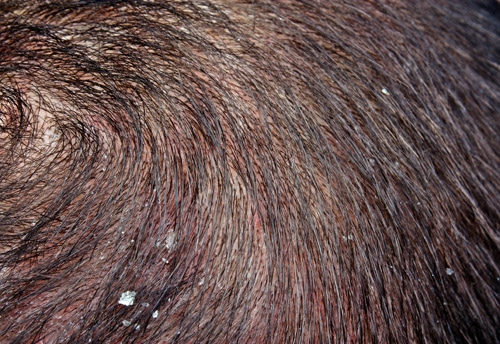Do you have red patches appearing in your hair, causing dandruff and severe itching? Is your scalp red and irritated? Do these patches extend from the scalp to certain parts of the face and you don't understand the cause? It could be seborrhoeic dermatitis. But don't panic! Although this condition is common and can be difficult to live with on a daily basis, it is nonetheless benign and non-contagious (you can't "catch" it). Once the symptoms of dermatitis (or seborrhoeic dermatitis) have been identified, and even if the causes of the disease are still poorly understood, treatments are simple and effective.
On the other hand, this skin condition is chronic and recurring, and scalp dermatitis can never be completely eradicated, as recurrences are unpredictable. Click here for everything you need to know about scalp fungi.
SYMPTOMS OF SEBORRHEIC DERMATITIS
Dermatitis appears in "flare-ups", starting with the appearance of a small patch on the scalp and then spreading to the scalp. The itching caused by the numerous flakes of dandruff is particularly irritating. The duration of an attack of dermatitis in the hair is variable, with patches appearing and disappearing without anyone really knowing why.
Seborrheic dermatitis of the scalp is characterized by pink, diffuse inflammatory patches, covered with a layer of oily, whitish scales or crusts, adhering to the epidermis, sometimes purulent - like juvenile acne pimples - and often causing severe itching.
Normally, the plates and scales of seborrheic dermatitis are less thick and persistent than patches of psoriasis. Another difference is that in the case of dermatitis on the scalp, the edges of these patches are more blurred and less defined than those with the clear contours of psoriasis. Finally, the fact that seborrhoeic dermatitis may spread to other key areas of the face (hairline, eyebrows, contours of the nose, etc.) can be another distinguishing feature from psoriasis. Psoriasis, when present on areas other than the scalp, tends to proliferate on the joints (elbows, knees, ankles, etc.).
Do not confuse seborrheic dermatitis with atopic dermatitis (or atopic eczema). These are two closely related chronic inflammatory skin diseases, but the former tends to prefer seborrheic environments - as its name suggests - whereas the latter develops on dry, or even very dry, skin and mainly affects the face and knuckles, not the scalp.
As for common dandruff conditions, caused by pityriasis, these can also lead to oily scales that stick to the scalp. In principle, however, this scaling does not cause underlying erythema and should not be confused with seborrhoeic dermatitis.
THE CAUSES OF SEBORRHEIC DERMATITIS
Like many skin conditions, eczema in particular, the causes of seborrhoeic dermatitis of the scalp remain poorly identified, although researchers now agree that a combination of three different factors is essential for its onset:
- The yeast of the Malassezia fungus,
- Hyperseborrhoea,
- Immune deficiency.
Malassezia is a fungus present on most human skin. Lipophilic, it colonises areas where sebaceous glands are most abundant and active. This is why oily scalps are favourable conditions for its development. But not all hyperseborrhoeic scalps develop seborrhoeic dermatitis, far from it. The third factor, an immune deficiency against malassezia yeast, is therefore the most likely hypothesis to explain its proliferation. More generally, it seems that immuno-depressed people suffering from a serious health problem (HIV, Parkinson's) are more often affected than others.
Aggravating factors:
In addition, it is thought that physical or psychological stress is an aggravating factor that encourages seizures.
It has also frequently been observed that the climate can have an impact on this dermatosis: a cold, damp environment is thought to favour its occurrence.
On the other hand, as mentioned above, if the disease proliferates in a hyperseborrhoeic environment, having skin that tends to be oily does not make it a necessary or sufficient cause. To date, the main consensus among experts is that hyperseborrhoea (on the skull or face) is only one factor, albeit an important one, but not a sufficient one, in triggering dermatitis.
TREATMENT OF SEBORRHEIC DERMATITIS
As soon as a small, sensitive area appears, or in case of a red, slightly irritated patch on the scalp, it's time to take care of it especially if you are subject to the risk factors listed above. The response to attacks of dermatitis is localised treatment ("topical treatment") as soon as an inflammatory flare-up begins. Unfortunately, a total cure for this chronic disease is not yet possible, but effective treatments do exist.
Medical treatment
In the event of major outbreaks, dermatologists often prescribe local corticosteroids for a limited period. A prolonged course of treatment risks irritating the scalp and having the opposite effect to that desired. They also prescribe treatments in the form of creams and shampoos containing three types of active ingredients: antifungal, anti-inflammatory and keratolytic (to encourage desquamation). Here again, however, these products should be used in moderation, as overuse can have a dual effect: it can make the skin rougher and it can strip the hair of vitality. Treatments often involve 2 phases: an attack phase during the inflammatory outbreak with an antifungal shampoo several times a week, followed by a maintenance phase after 4 to 6 weeks in which the treatment shampoo is spaced out until the symptoms disappear.
Natural treatment
At Centre Clauderer, following a hair diagnosis, your specialist will recommend applying a purifying, cleansing and above all very gentle lotion adapted to the nature of your scalp. These multi-purpose milks provide a long-lasting rebalance to the affected areas, gently removing flaky skin and soothing itching. They also help regulate sebum secretions. The product should be applied before shampooing, with a cotton pad soaked in water, dabbing carefully into sensitive areas. Recommended application time: just a few minutes to allow the active ingredients to penetrate the dermal tissues.
As with psoriasis or eczema, you can supplement your hair care routine with a mixture of vegetable oil and purifying essential oils, especially if you regularly use a shampoo that is too harsh. Choose a good quality neutral oil. A light massage, if done properly, will soothe the tension linked to itching while moisturising the hypersensitive skin of the skull.
If you are concerned that intensive scratching sessions have also damaged your hair, your Clauderer Specialist will suggest an additional treatment for hair regrowth when the dermatitis attack has subsided.
Taking care of yourself
As well as local treatment to alleviate the effects of attacks, adopting a healthier lifestyle can help you to space them out over the long term, not to mention the long-term benefits for your general health!

For example:
1. To limit hyperseborrhoea, avoid industrially processed cereal products such as cakes, white bread and rice, industrial flours and sugars, fast food, etc. This type of food triggers a cascade of hormonal events that can encourage excessive secretion. of sebum.

2. To help flaky, itchy skin disappear, limit the number of times you use acidifying foods - particularly dairy products - and increase your consumption of salads, green vegetables and fresh fruit.

Obviously, scrupulous hygiene is essential and scratching the scabs should be avoided at all costs.
For women on contraception or HRT
The progestins with a positive effect on the hair (cyproterone acetate, drospirenone, desogestrel, dydrogesterone...) limit sebaceous secretions, make the scalp less oily and can represent an interesting preventive and therapeutic treatment against attacks of seborrhoeic dermatitis.
Who can get seborrhoeic dermatitis in the hair?
While there is no "typical profile", since even infants can suffer from it (the famous "cradle cap"), according to our observations, young men (aged 18-35) suffer more often from this skin condition than women in the same age bracket. For women, the condition is more common after the menopause. The scalp becomes more vulnerable to the secretion of androgens and sebum when the female hormones have disappeared. Hyperseborrhoea can also be observed during this hormonal upheaval. Overall, around 3% of the population is thought to be affected by this skin condition.
Does dermatitis cause hair loss?
Seborrheic dermatitis is not a trigger for hair lossThe two conditions can coexist on the same scalp. Of course, in the event of an acute attack, there is always the risk of pulling out a patch of hair in an attempt to relieve the itching. In this case, once the skin on the scalp has healed, the hair follicles will resume their normal activity and the hair will grow back naturally, without the need for any special treatment.

